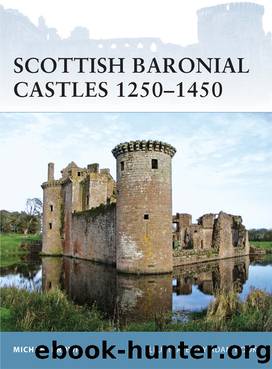Scottish Baronial Castles 1250-1450 by Michael Brown

Author:Michael Brown
Language: eng
Format: epub
Tags: Scottish Baronial Castles 1250–1450
ISBN: 9781782007050
Publisher: Osprey Publishing
THE CASTLES REBUILT, 1350–1450
The great castles
Though the long war with England continued until late in the 15th century, from the late 1350s it was a struggle of border invasions and long truces. The years of major conflict were over, but they left Scotland’s castles in ruins. Of the great baronial residences, we have evidence of destruction at Bothwell, whose donjon was half torn down, at Caerlaverock, where the gate towers, the walls and the angle towers were all left only as stumps by the 1350s, and at Dirleton, where two of the towers were demolished. Literary or archaeological evidence similarly reveals damage or destruction at the castles of Balvenie, Kildrummy and Castlehill of Strachan in the north, Buittle and Cruggleton in Galloway, Dundonald in Ayrshire and St Andrews in Fife. However, as the threat posed by the English king’s garrisons faded in the 1340s and 1350s, Scotland’s nobles once again sought to construct buildings that were both defensible and settings for a lordly household and following. In the decades from 1350 to 1420 a new wave of castle-building produced reconstructed houses across the kingdom. The greatest of these were the work of the winners in the recent wars. The noble houses of Stewart and Douglas had upheld the Bruce cause and had risen to hold earldoms and lordships in many parts of Scotland. Magnates from these families built to display and cement their leadership of whole provinces.
Probably the first and, arguably, the best expression of this can be found at Tantallon in East Lothian, a few miles from Dunbar and Dirleton. It was here, on a cliff top overlooking the Firth of Forth, that William first earl of Douglas built a massive castle. This centred on a promontory site that could only be approached across a neck of land from the west. Douglas had this defended by the construction of a huge curtain wall of red sandstone, 15 metres high and nearly four metres thick. The thickness of the wall allowed chambers to be built within it. Towers were built at each end of the curtain wall and a mid-tower contained the gate into the inner courtyard. This mid-tower was constructed on a 15-metre-square plan and must have stood some 20–25 metres high, containing five storeys. The gate was protected by small projecting turrets and, slightly later, the defences were strengthened by the construction of a barbican. This twin-towered outer gatehouse acted as a further line of defence for the weak point in the wall.
Download
This site does not store any files on its server. We only index and link to content provided by other sites. Please contact the content providers to delete copyright contents if any and email us, we'll remove relevant links or contents immediately.
| Africa | Americas |
| Arctic & Antarctica | Asia |
| Australia & Oceania | Europe |
| Middle East | Russia |
| United States | World |
| Ancient Civilizations | Military |
| Historical Study & Educational Resources |
The Radium Girls by Kate Moore(11921)
100 Deadly Skills by Clint Emerson(4840)
Rise and Kill First by Ronen Bergman(4701)
The Templars by Dan Jones(4627)
The Doomsday Machine by Daniel Ellsberg(4415)
The Rape of Nanking by Iris Chang(4136)
Killing England by Bill O'Reilly(3951)
Hitler in Los Angeles by Steven J. Ross(3900)
Stalin by Stephen Kotkin(3875)
12 Strong by Doug Stanton(3508)
Hitler's Monsters by Eric Kurlander(3268)
Blood and Sand by Alex Von Tunzelmann(3138)
The Code Book by Simon Singh(3074)
Darkest Hour by Anthony McCarten(3070)
The Art of War Visualized by Jessica Hagy(2943)
Hitler's Flying Saucers: A Guide to German Flying Discs of the Second World War by Stevens Henry(2714)
Babylon's Ark by Lawrence Anthony(2620)
The Second World Wars by Victor Davis Hanson(2480)
Tobruk by Peter Fitzsimons(2443)
